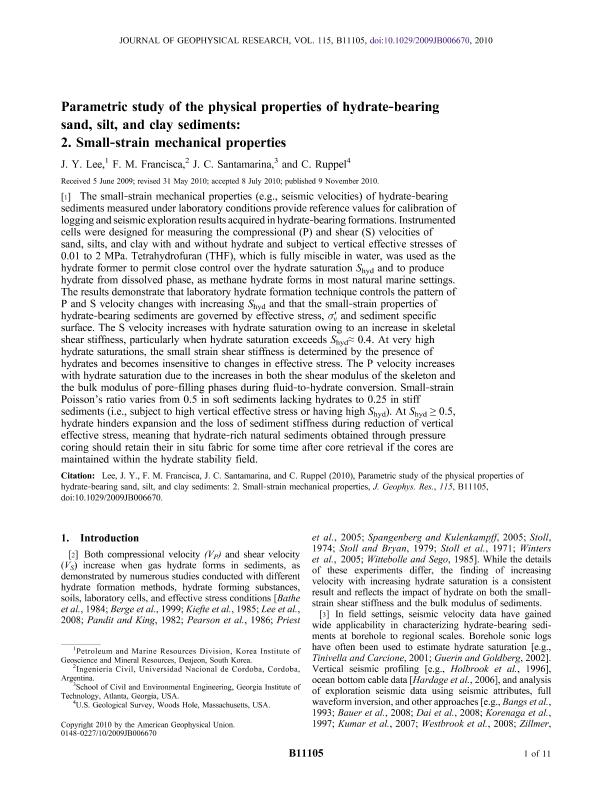Artículo
Parametric study of the physical properties of hydrate-bearing sand, silt, and clay sediments: 2. Small-strain mechanical properties
Fecha de publicación:
09/11/2010
Editorial:
American Geophysical Union
Revista:
Journal of Geophysical Research: Solid Earth
ISSN:
2169-9356
e-ISSN:
2169-9313
Idioma:
Inglés
Tipo de recurso:
Artículo publicado
Clasificación temática:
Resumen
The small‐strain mechanical properties (e.g., seismic velocities) of hydrate‐bearing sediments measured under laboratory conditions provide reference values for calibration of logging and seismic exploration results acquired in hydrate‐bearing formations. Instrumented cells were designed for measuring the compressional (P) and shear (S) velocities of sand, silts, and clay with and without hydrate and subject to vertical effective stresses of 0.01 to 2 MPa. Tetrahydrofuran (THF), which is fully miscible in water, was used as the hydrate former to permit close control over the hydrate saturation Shyd and to produce hydrate from dissolved phase, as methane hydrate forms in most natural marine settings. The results demonstrate that laboratory hydrate formation technique controls the pattern of P and S velocity changes with increasing Shyd and that the small‐strain properties of hydrate‐bearing sediments are governed by effective stress, s′ v and sediment specific surface. The S velocity increases with hydrate saturation owing to an increase in skeletal shear stiffness, particularly when hydrate saturation exceeds Shyd≈ 0.4. At very high hydrate saturations, the small strain shear stiffness is determined by the presence of hydrates and becomes insensitive to changes in effective stress. The P velocity increases with hydrate saturation due to the increases in both the shear modulus of the skeleton and the bulk modulus of pore‐filling phases during fluid‐to‐hydrate conversion. Small‐strain Poisson’s ratio varies from 0.5 in soft sediments lacking hydrates to 0.25 in stiff sediments (i.e., subject to high vertical effective stress or having high Shyd). At Shyd ≥ 0.5, hydrate hinders expansion and the loss of sediment stiffness during reduction of vertical effective stress, meaning that hydrate‐rich natural sediments obtained through pressure coring should retain their in situ fabric for some time after core retrieval if the cores are maintained within the hydrate stability field.
Palabras clave:
HYDRATES
,
SHEAR WAVE VELOCITY
,
SOIL MODULUS
,
CHARACTERIZATION
Archivos asociados
Licencia
Identificadores
Colecciones
Articulos(CCT - CORDOBA)
Articulos de CTRO.CIENTIFICO TECNOL.CONICET - CORDOBA
Articulos de CTRO.CIENTIFICO TECNOL.CONICET - CORDOBA
Articulos(IDIT)
Articulos de INSTITUTO DE ESTUDIOS AVANZADOS EN INGENIERIA Y TECNOLOGIA
Articulos de INSTITUTO DE ESTUDIOS AVANZADOS EN INGENIERIA Y TECNOLOGIA
Citación
Lee, Joo Yong; Francisca, Franco Matias; Santamarina, Juan Carlos; Ruppel, Carolyn; Parametric study of the physical properties of hydrate-bearing sand, silt, and clay sediments: 2. Small-strain mechanical properties; American Geophysical Union; Journal of Geophysical Research: Solid Earth; 115; B11; 9-11-2010; 1-11
Compartir
Altmétricas




